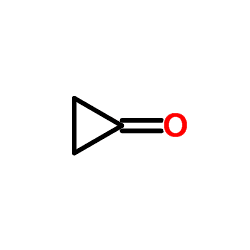Formula C3H4O | Density 867 kg/m³ | |
 | ||
Cyclopropanone is an organic compound with molecular formula C3H4O consisting of a cyclopropane carbon framework with a ketone functional group. The parent compound is labile with melting point −90 °C and has been prepared by reaction of ketene with diazomethane at −145 °C. Derivatives of cyclopropanone are of some interest to organic chemistry.

In organic synthesis the use of cyclopropanone itself is substituted by that of synthons like acetals cyclopropanone ethyl hemiacetal or cyclopropanone ethyl trimethylsilyl acetal.

Derivatives
Cyclopropanones are intermediates in the Favorskii rearrangement with cyclic ketones where carboxylic acid formation is accompanied by ring-contraction.

An interesting feature of cyclopropanones is that they react as 1,3-dipoles in cycloadditions for instance with cyclic dienes such as furan. An oxyallyl intermediate or valence tautomer (formed by cleavage of the C2-C3 bond) is suggested as the active intermediate or even a biradical structure (compare to the related trimethylenemethane).

Experimental evidence is not conclusive. Other reactions of cyclopropanones take place through this intermediate. For instance enantiopure (+)-trans-2,3-di-tert-butylcyclopropanone racemizes when heated to 80 °C.
An oxyallyl intermediate is also proposed in the photochemical conversion of a 3,5-dihydro-4H-pyrazole-4-one with expulsion of nitrogen to an indane:
In this reaction oxyallyl intermediate A, in chemical equilibrium with cyclopropanone B attacks the phenyl ring through its carbocation forming a transient 1,3-cyclohexadiene C (with UV trace similar to isotoluene) followed by rearomatization. The energy difference between A and B is 5 to 7 kcal/mol (21 to 29 kJ/mol).
